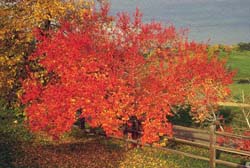There are few true xeriscape-type trees, and a few more xeriscape-type shrubs. Grasslands are a natural feature of the Colorado plains. Trees are sparse in these areas due to the seasonality and low levels of rainfall, amounting to only 14 inches in many parts of the state. The rainfall we do receive is unevenly distributed throughout the year. Although rainfall can, to some extent, be supplemented through irrigation, climate limits the type of trees that grow, particularly in a landscape where saving water is a goal.
What deciduous trees can be used for xeriscape?

Bur oak, golden rain tree, common hackberry, Kentucky coffee tree, thornless honey locust and western catalpa are examples of large deciduous trees that are adapted to xeriscapes. Small xeric trees include big-tooth maple, tatarian maple, Russian hawthorne, piñyon pine and gambel oak. Note that all trees require adequate water during the minimum two to three year establishment period.
What evergreen trees can be used for xeriscape?
Evergreen trees for xeriscapes include ponderosa pine, Rocky Mountain juniper and one-seed juniper. These are native to the low drainage areas in the plains, as well as the foothills and mountains where slightly more water is available.
What shrubs can be used for xeriscape?
There are many more shrubs available to plant in xeriscapes. Yucca, peashrub, rabbitbrush, saltbush and sage lend a western dry-country look to xeriscapes. Other varieties, such as three-leaf sumac, sand cherry, cotoneaster and potentilla are more green and lush in appearance. Shrubs that make good screens include the New Mexico privet and the buffalo berry. Apache plume, cliff rose and lead plant feature interesting flowers. Whatever variety you choose, remember that all shrubs require a period of at least a year with adequate water after transplanting to become established.
Many nurseries have xeriscape sections that feature these trees and shrubs, and staff who can guide you to other xeriscape plants.
For more information, see the following Colorado State University Extension fact sheet(s).



